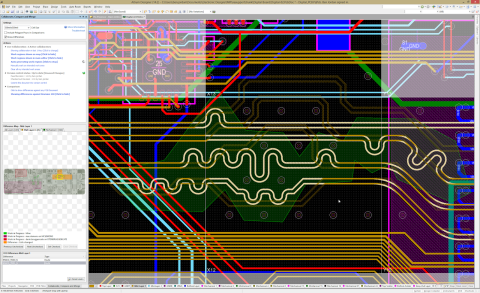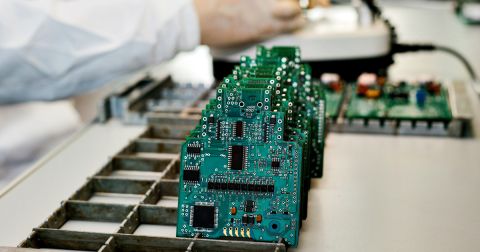Project Conception in the Project Management Lifecycle

What is the Project Conception?
There’s often a strong temptation in most electronics development projects for the design team to take an idea they like and run with it. Usually, this will work out, particularly for small businesses operating in a niche market that they understand. However, there can be a real risk that the project will fail for all manner of reasons. These can range from the initial idea being flawed or impractical with current technology. Components may have unacceptably long lead times or be prohibitively expensive. Alternatively, the same concept may have already been made into a product that has saturated the market, leaving little space for competitors to exploit.
The project conception phase encompasses critical tasks for ensuring a product’s success before spending effort developing a potential white elephant. Activities include initial requirements capture and verification, feasibility studies, and proof of concept prototypes.
The stakeholders need to ensure that they understand the problem that the proposed product is looking to solve. Reach a consensus that the idea is practical and there is a potential market for it. It’s no use solving a problem that doesn’t exist or producing a product that no one wants to buy.
Project conception is turning an idea for a circuit design into a product that solves a problem. The steps it encompasses will help establish a definitive set of requirements that the development team can use to design a circuit, lay out a PCB, assemble the components, and build a product that customers want.
Initial Activities
The concept phase of a projecgt starts with initial research steps to prepare for any electronic device's design and development activities. After that, it’s primarily focused on gathering all the data required to inform the design activities. Finally, its purpose is to define the business drivers for the product, and the reasons it’s going to be developed.
A product needs a market and a demand to be successful, whether it's a novel circuit design or an enhancement of an existing design. Determining this requires a broad understanding of the current marketplace, the competition, and the product’s value proposition.
The market needs to be understood in terms of the demographics of the target customers, their needs and expectations, and their budget. Of course, an overly expensive product will not be successful, but this is a subjective measure that can be tough to establish at the start of the product life cycle.
The Importance of Product Conception
Every electric product on the market solves a problem that the person buying the product needs to solve. It is pointless to develop a new product if the problems that the product aims to solve are not known and understood. The success of development projects will come down to providing the solution that the consumer wants for their problem, exactly when they need it.
Even then, if the product is perfect and at the right price, it still may be unsuccessful if competitors have already saturated the market and removed consumer demand. Thus, in the race to get a new electronic product to market first, effective product lifecycle management will play a large part in getting the product through conception and into manufacturing as quickly as possible.
Technology-based product development projects are renowned for overspending and delivering late. Sometimes this product management failure can be so dramatic that the development company fails. However, proper product management planning can significantly increase the likelihood that a product’s development will be completed on time and within budget.
Product Conception PCB Purpose
Electronic product development must have a tightly described scope, defining what the product is required to do and, importantly, what it is not required to do. The main driver for the scope definition is an understanding of the customers and their expectations. This knowledge allows early identification and mitigation of development pain points, influencing design decisions to avoid issues and create opportunities for improvement.
The conception phase will also bring together cross-domain viewpoints from a broad range of stakeholders to influence the development process. For example, circuit designers, component sourcing, PCB layout, and manufacturing all have an input to make. Developing electronic devices can sometimes be a discipline with a narrow field of view, focused on the technical details of the device rather than the bigger picture of how it will be used. Getting involvement from users, sales and marketing, management, and other interested parties can reduce the risk of developing a product that the market doesn’t want.
The end goal of the initial conception phase activities is ultimately to enable the senior management to make an informed decision as to whether they should green-light product development or halt the project management life cycle. The drivers for this decision will be the viability, cost-effectiveness, and expected market demand for the product. An unviable electronic product cannot be developed, while a cost-effective product will never make sufficient profit to pay the development costs. Likewise, a product with an insufficient market demand will not reach its sales targets. The bottom line is that an electronic product will only be developed if its sales generate income that is sufficiently greater than the costs of designing, manufacturing, and shipping the product.
Avoiding Problems with the Product Conception Phase
The main benefit of running a product conception PCB activity is preventing the development process from running with incomplete or erroneous information that adversely affects the final design. In addition, it should result in the agreement between all stakeholders that the proposed product is what everyone wants and what the end customers need.
There’s no point in letting the development team start the circuit design process if there are any misunderstandings, ambiguities, or misconceptions about what everyone wants. Therefore, the stakeholders’ list needs to be as wide and inclusive as possible to cover all possible viewpoints.
It’s not uncommon for undocumented assumptions or unwritten requirements to appear following the completion of development when the prototype doesn’t do what some stakeholders thought it would do.
At this point, the team has spent money producing a prototype PCB and enclosure that they can't recover.
It’s also common for new products to be built on the back of existing products, reusing schematic designs or PCB layouts to get a head start on the development. The downside is that this approach can stifle innovation and result in missed opportunities to develop a more elegant solution with better performance or a cheaper bill of materials.
The product conception phase activities should help establish all the requirements, constraints, and assumptions upfront in forms that enable universal understanding by all stakeholders and reduce project management life cycle failure opportunities.
Risk identification, analysis, and mitigation are essential parts of the product management lifecycle. The earlier risks are recognized, the easier and cheaper it is to eliminate them or reduce them to acceptable levels. The product project conception phase of a project helps achieve this.
Product Conception PCB Goals
The key to successful electronic product development is the requirements the design team uses to develop the product.
The documented requirements must be complete; there must be no requirements that appear after the design phase has already started that could cause costly circuit redesign activities that delay the product development.
The requirements must be coherent; there must be no conflicts or mutually exclusive statements that will require resolution when disagreements are found during the design process. Or even worse, issues only identified after the mounting of sourced components on a prototype PCB that requires a return to step one of the circuit design process.
The requirements must be correct; they must have been verified to ensure no errors, misunderstandings, or uncertainties are present in the text that could lead to the design team making the wrong decision.
The benefit of getting the requirement right before development starts is eliminating any potential scope creep that can delay progress and incur unexpected costs.
The product project conception phase of an electronic device development project will help remove uncertainty by defining clearly understood goals, creating firm requirements, identifying risks, establishing the product’s viability, and setting reliable development timescales and budget needs. The conclusion of the product project conception phase provides the opportunity to make a fact-based go/no-go decision for the development phases. It lets you know if the new product will deliver a return on investment before development starts rather than after the circuit board has been assembled.
Would you like to find out more about how Altium Designer® can help you with your next PCB design? Talk to an expert at Altium.









